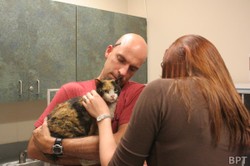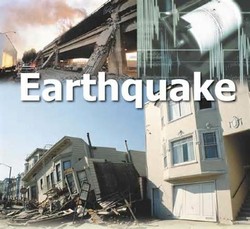I’ve done just about everything I can to prepare my family and myself when (not if) another earthquake hits the area in California where we live - and it will happen experts say. I’ve completed all the training, I’ve taken Red Cross emergency and first aid classes, and I’ve taken training by our local fire department. The U.S. Federal Emergency Management Agency (FEMA) has even certified me for having taken several of their emergency management courses. There are emergency kits in our cars, in our house and we’re ready for just about anything, or at least as ready as one can be.
But, there’s one area of concern and preparation I nearly forgot about when putting together all our plans – pets. Yes, our furry friends need our help too. After all, they can’t do anything but run away when a disaster strikes and that’s not going to be good enough.

Disasters And Pets: Are You Ready To Aid Your Pet When An Emergency Hits?
Are you ready to take care of your pet in a natural disaster or emergency. Here are some tips.
Earthquakes are unique natural disasters in that they don’t give you much warning. Fires and floods you pretty much know about somewhat in advance. But, when the earth shakes you’ll have little time to get an emergency kit put together. In fact, you’ll have no time to do anything but “duck, hold and cover.” However, no matter what the emergency having emergency supplies ready for you, your family, and your pet is a must.
Families with a disaster plan in place will be better equipped to stay safe and recover from an emergency and that goes for your four-legged friends as well. While there may be a dedicated emergency pet shelter available, the best plan for dealing with an emergency starts at home.
Have A ‘Go Kit’ For Your Pet
Just like with humans, having a “go-kit” for your pet is important. A go-kit is a quick-grab, easy to carry suitcase or backpack or container that has essentials like some food and water and, in the case of humans, important documents (like insurance). For pets it is much the same – food, water and other essentials (like your pets’ medications). Remember, in many disasters emergency officials will clearly tell you that if it is a widespread disaster you need to be ready to manage for several days by yourself, even in a big city, because first-responders could be overwhelmed.
What should a pet go-kit contain? Start with the following:
1. Keep at least three-day supplies of both your pet’s favorite food - in a waterproof container - and bottled water.
2. Make sure your pet can be identified by having either a microchip identifier inserted by your vet or a collar ID tag and make sure the contact information is up-to-date.
3. First aid supplies that might be unique for your particular type of pet. You might stuff a pet medical book or brochure in there as well.
4. A spare safety harness and/or leash are a must.
5. Waste cleanup supplies. You’ll be surprised but depending on how long you may be out of your house or apartment your pet could need a lot of waste disposal supplies. And other people you may be sheltered with will very much appreciate not having to tippy-toe around your pet’s leavings.
6. Of course, bring along any medications your pet needs and copies of its medical records. You might also add a contact list of veterinarian and pet care organizations in case someone else needs to know what to do if you are not immediately around and something goes wrong. Also keep a document that details any information on your pet's feeding routine and any behavioral issues; comfort toys; and a blanket. If you are sheltered for a long time because of a disaster your pet will get bored – after all it doesn’t know what’s going on; it just wants to get into a normal routine and keeping it occupied is important.
Things To Do Before A Disaster
So you have your pet emergency go-kit all put together (by the way, you may need several kits; one for your car, for example), but there are several things you can do before a disaster strikes. Here are some tips:
1. Display a pet rescue decal on your front door or window to let first responders know there is a pet in the house. Include your veterinarian's contact information.
2. Know where your pet likes to hide in your house when they are frightened. Finding them quickly will help you evacuate faster. Sometimes a bell on your pets collar can help.
3. Identify a location to take your pet if you need to leave your immediate area. Keep in mind that disaster shelters for people may not be open to pets. Locate hotels and motels with pet-friendly policies and ask relatives or friends if they could house you and your pet.
4. Carry a picture of your pet in your wallet or purse in the event you are separated from your pet.
5. If you need to evacuate have a pet carrier or crate ready to go for transport and safekeeping.
Caring for your pet is important in good times as well as bad. You have a commitment to take care of it no matter what happens. Being prepared is important because when a disaster strikes you’ll have very little time to take action. That’s important for both the humans you love and the pets you love as well. Spending a little time to get prepared now will be critical should the need arise.
You might also like
What Not To Do In An Earthquake – Grab Your Cell PhoneWhen a quake hits, do you know what to do - and what not to do? Resist making...
Rusty Blackbird - How to Save This Vulnerable SpeciesEcology and conservation issues associated with the Rusty Blackbird, Euphagus...









 The Problem With Wizzley and Amazon Associateson 10/17/2014
The Problem With Wizzley and Amazon Associateson 10/17/2014
 Happy Wife, Happy Life: Is It True?on 10/02/2014
Happy Wife, Happy Life: Is It True?on 10/02/2014
 Arborsculpture Designs Are Beautiful And Practicalon 09/30/2014
Arborsculpture Designs Are Beautiful And Practicalon 09/30/2014
 The Religious And Immoral Actson 09/23/2014
The Religious And Immoral Actson 09/23/2014



Comments
Revisiting your wizzley brought to mind a question that I had intended to ask with the first reading.
Is there any reputable place that offers training in disaster preparedness for our canine and feline and other sentients? It might be as challenging to get all our sentient family members into getaway vehicles as out of hiding places.
TheWritingCowboy, It's important to track animal behavior since pets and wildlife often sense the subtle changes that precede, and build into, disasters.
This is very good advice. Thank you.
Thanks
Excellent Advice! Here in Texas there are people who volunteer for emergency stabling for horses - mostly used when there is flooding.